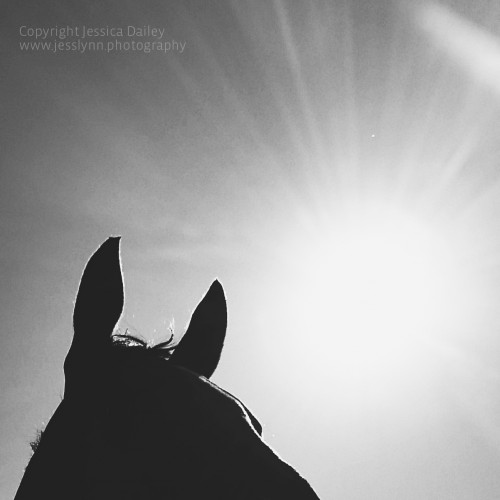My first digital camera changed my recorded equestrian life. Gone were the awkward, ginormous-head-tiny-rump photos I’d so often caught on film years prior. Now, when my horse moved from where I’d placed him (which he usually did) or when I got the light all wrong (which I usually did) or when the devilish red “barn eyes” were more than a clumsy editing tool could conquer, I just pressed delete and hurrah! The bad photo was no-more, vanquished, erased. All it took was another “click,” and I could try again, ensuring the pictures-for-keeps showed only my horse’s good side.
Of course, to most casual photo-takers today, the very idea of a digital camera sounds dated. We’re all pretty much bound to our smartphones and the ease with which we can snap and share every horsey adventure instantly. But just because we all have quality cameras literally in our pockets and at our fingertips, at all times, doesn’t mean the pictures are all that great. And of course, if we want to share our pics on social, we want them to be fab!
With horses and smartphones in mind, TSB reached out to professional photographer Jessica Dailey for guidance. Jessica recently provided over 1,200 (yes, you read that right) color photographs for the bestselling TSB book, World Class Grooming for Horses, by pro grooms Cat Hill and Emma Ford. Many of the excellent images in the book are step-by-step, although Jessica took pains to include a number of “beauty shots,” as well. With that kind of in-depth “horse-flavored” work on her resume (on top of her usual commercial art, fine art, event photography, and portraits, which she takes on a freelance basis) we figured Jessica could give us some great tips for taking sensational photos with our phones.
“I have loved art since I was a kid,” she says, “and that evolved into a love for photography as I got older. As a kid I remember being fascinated with my father’s old film camera. The weight of the lenses in my hands, and the way the world looked through the viewfinder.”

“The light shining in through the barn on this day was spectacular,” says Jessica. “I love interesting light. I got very low to the ground and let the light shine directly into my phone camera. This is what created the rays of light. I then edited it with a warm filter, so you can almost feel the sunlight touching your face.”
Jessica went to college for accounting (she’s a CPA), but in her late twenties, she says she began to feel “out of balance.”
“I felt like the beauty of the world was passing me by,” she remembers, “so I picked up a camera, and the rest is history! I can feel something deep in my heart when I’m behind the camera. When there is a lump in my throat, or tears streaming down my face, I know it’s a good subject.”
Jessica, who is largely self-taught, usually shoots with a Canon Mark III, 24-70 2.8, 70-200 2.8, 100 2.8 Macro, 50 1.4, and 85 1.8.
“There are a few more tricks in my bag,” she admits, “but those are the ones most frequently used.”
Of course, we’re not here to talk about serious camera equipment! So what kind of phone does Jessica have? And does she use it to take some of those gorgeous photos you can see on her website?
“I currently have a Samsung Galaxy S5,” she says. “I actually don’t like the aspect ratio—the photos are very wide. It also distorts the images a bit near the edges, so sometimes people’s heads look out of whack. It over-sharpens the images, making them look a little ‘crunchy.’ (You’ll notice this is in the images I’ve included here.) I really do love the photos that the iPhone takes. The shutter is fast; there’s not a lot of waiting around for the phone to focus.

This shot and edit reminded Jessica of a vintage Polaroid. “I tried to get a little bit of the tree in the background, but not at an angle where it looks like the tree is growing out of the horse’s back.”
“Believe it or not, I find taking pictures with a phone much more difficult than my camera, because adjustments are more tedious to make! I can make changes to any aspect I want within seconds on the camera, but if I want to change the ISO, or flash, on my phone, I have to click what feels like 16 times to get to the menus I need. That might actually be a function of not having found the best camera app yet. (Sometimes searching for new apps falls to the bottom of the list when life gets hectic…)
“Lately, my favorite seems to be VSCO Cam. This app does have a pretty decent camera function with advanced camera controls, including manual focus, shutter speed, white balance, and exposure compensation. As far as editing, the VSCO Cam film presets are absolutely stunning. You can edit and tweak them very easily, and the app comes with lots of free presets. Most of the photos here were shot with my Samsung S5 camera app, edited with VSCO Cam, then tweaked just a bit within VSCO Cam app. Instagram photo editing is pretty great too. They’ve updated the features that allow you to customize their presets.”

“This shot I edited a couple of ways. I like the washed-out look sometimes, which was how I edited this one…”

“…and here it is again with additional color.”
So when we’re taking pictures of horses on our phones, what are some rules of thumb in terms of composition, handling still shots, handling action shots, and getting perspective right (avoiding the ginormous-head-tiny-rump problem of my film-camera years)? Here are Jessica’s top tips for all the ringside snapping you plan to do:
1. Try not to cut off feet/ears/tails (Editor’s note: As book publishers, we wholeheartedly endorse this! Nothing is as aesthetically displeasing as horse toes and hat tops disappearing at the edges of a photograph.)
2. Keep the horizon level. (You wouldn’t believe the number of photos we have to rotate prior to publication so it doesn’t appear that every horse is stabled on a downhill slant…)

“The same shot…”

“…with two different feels.”
3. Tap the phone screen to refocus on your subject (not the background).
4. When shooting from the side, always watch out for big-butt/little-head syndrome (you are standing closer to the horse’s rear so it looks disproportionately larger than the head) and vice-versa.

“This photo is like a postcard from the Old West, so I amplified that effect.”
5. Most importantly, if you are using a flash, stand back and take a few test shots to see what kind of reaction you’re going to get from the horse.
6. If it’s dark, your phone will keep its camera shutter open longer in order to let more light in. The built-in flash on most phones is not powerful enough to compensate for dark conditions, so it’s best to stick to shots of horses standing very still when the light is not bright.

“This was taken in BRIGHT full sun. I lean toward a B&W edit in these cases.”
7. If you are shooting outside and it’s a bright sunny day, you should have no trouble getting some jumping or galloping shots. Your best bet for capturing non-blurry fast-moving subjects is bright light. (“And I mean full-sun type-of-bright,” Jessica emphasizes.) If there are heavy clouds, or you are indoors, it can be difficult to get a smartphone camera to capture motion, although some phones have a sports mode meant for capturing fast-moving subjects, which can help. (Some apps can add sports mode to your phone.) Try turning off “image stabilization” if you are having trouble focusing quickly. You shouldn’t need it in bright sun anyway.

“Don’t be afraid to shoot directly into the sun, which is what I did here.”
8. To get a great portrait shot of your horse (posed), it’s best to enlist the help of a friend with a candy wrapper or a mint. (Jessica says this can take some patience, but it proved to be VERY effective when she was shooting images for Word Class Grooming for Horses.) Have your friend stand just out of view of your photo and crinkle the wrapper after you have everyone else in place and ready to go. The wrapper will usually get eyes and ears perky and forward.
9. To get a more candid, natural picture, you have to have the photo on your mind and be looking through your phone camera, ready to snap at the right moment. If you wait to pull out your phone until the moment is happening, you will undoubtedly miss it.
10. Don’t be afraid to look at things from a different perspective. Get really low, or go behind the bushes and peer through. This new viewpoint can produce some really interesting shots.

“I get low/high, or point up/down.”

“Shooting behind the dandelions adds a new element of interest.”

“I tap on the screen to intentionally focus on the foreground.”
11. Although it’s not ideal, you can also crop down an image after you capture it to make it more interesting. Sometimes there is a part of a photo you might not like or that is blurry. Try getting creative with your crop before deleting it all together.

“I got low to the ground to used the sun to create a silhouette.”

“Cropped into something completely different!”
About the Author
 Trafalgar Square Books is the leading publisher of equestrian books and DVDs. Check out the full catalog at www.horseandriderbooks.com.
Trafalgar Square Books is the leading publisher of equestrian books and DVDs. Check out the full catalog at www.horseandriderbooks.com.




 September 1, 2015
September 1, 2015 






















